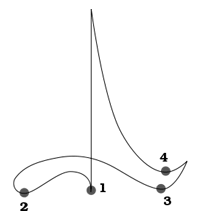Ukulele Big Band: A How-to Guide
A Fresh Approach to Ensemble Playing
By James Hill
I often hear the following comment from ukulele enthusiasts: "I play in a ukulele jam – which I enjoy – but I'm looking for fun arrangements that have multiple parts." Well, here's something new for your ukulele jam and/or ensemble: Ukulele Big Band.
The Ukulele Big Band Challenge
When you're strumming in a uke jam, you play – by and large – the same thing as everyone else. That's part of the fun, of course! However, if you step outside to take a phone call, no one will really notice that your part is missing (the bigger the group, the more truth there is to this). This isn't the case, however, in a ukulele big band where each part is an essential cog in the wheel. The result? Players take pride in learning/knowing their music because the whole depends on the parts.
In my experience, most people enjoy the challenge that ukulele big band presents. True, learning to play your part might take more effort than learning to strum a three- or four-chord song, but most people I've worked with relish the opportunity. Why? Because it's something fresh, because the end product can sound wonderful, and because it gets them "inside the music" in a new way.
If this sounds interesting to you, read on as we explore some of the main features of a big band arrangement; I'll also offer some advice for conducting your own big band.
Before You Begin
Here are a couple of things to consider before you begin.
Chairs and Stands
Set yourself (and your band) up for success. Set up your big band so that those playing the same part are sitting together. Each "section" of the band should be organized in pairs of players where each pair of players shares a single music stand. This will greatly help you to make the most of your rehearsal time and to minimize clutter. I like to put Uke I on my far left and Uke IV (or in some cases Uke V) on my far right.
Tuning
All of the arrangements I’ve published are available in both C6 (g, c, e, a) and D6 (a, d, f#, b) tuning (link). In cases where you have mixed class, you’ll need both in order to use the mixed-tuning teaching strategies outlined in this article.
The Anatomy of a Big Band Arrangement
Standard jazz tunes, in general, follow what is known as "chorus form." Why? Because early on, jazz musicians threw out the the verses of Broadway showtunes and music hall hits, opting instead to play just the catchiest parts (the choruses)[1]. They used the chord progressions of these choruses as foundations for their improvisations. A melody in "chorus form" is usually 16 or 32 bars with four phrases arranged like this:
A) Main theme (e.g. "I got rhythm...")
A) Main theme, often with variation (e.g. "I got daisies...")
B) Contrasting "bridge" section (e.g. "Old man trouble...")
A) Main theme (e.g. "I got rhythm...")
This is also called "AABA" form (no surprises there). One full statement of the theme (AABA) is said to be "one chorus." Herein lies the flexibility of a jazz arrangement: the chorus can be repeated as many or as few times as is necessary. A typical big band arrangement follows this sequence:
1.Introduction
Optional (often just the chords of the final "A" section)2.Opening chorus
The melody as written (this is called "the head")3.Middle choruses
improvisations happen here (repeat as needed with and without background figures)4.Final chorus
Re-statement of the head or a "shout chorus"5.Ending
Optional
Note that in the middle choruses (where a soloist is invited to improvise a new melody over the chord progression of the song), the melody is omitted. Those who played the melody during the head (i.e. Uke I players) are invited to strum the chords instead. Those on ukulele parts II, III, IV (and sometimes V) play only when cued by the bandleader. These parts become background figures during the soloist's improvisation; a kind of musical "recycling." I like to give the soloist at least two choruses and to bring back ukulele parts II, III, IV and V on the second time. This adds variation and helps to "lift" the solo toward the "shout chorus".
The "shout chorus" is the climax of the arrangement (see the free arrangement included in this issue for an example). It's where the whole band gets to shine (and the arranger gets to show his/her creative side). The shout chorus is the time for thick harmonies, strident rhythms and lots of volume!
Watch the following video clip (filmed at the 2010 Dallas Ukulele Festival after just 3 hours of rehearsal over 2 days). See if you can identify the five sections of the arrangement: introduction, opening chorus, middle choruses (solos), shout chorus and ending.
Now let's explore the basics of conducting a ukulele big band.
How to Lead a Big Band
Most big bands have a bandleader (think Glenn Miller, Duke Ellington, Count Basie et al.), someone who directs rehearsals and conducts performances. In my view anyone can be a successful bandleader as long as he/she sticks to three simple rules:
1. Know your material
2. Conduct clearly
3. Don't ego-trip
Know Your Material
Pretty self-explanatory, really. Without putting too much pressure on yourself, be sure you can do the things you're asking others to do. That's the best way to be authentic and believable: know your stuff. That means you should be able to play each of the four or five parts in the score. Familiarize yourself with the Teaching Notes that accompany your big band score.
Conduct Clearly
Most big band scores have four beats in each measure (called "common time" or "4/4 (four-four) time"). You don't need to have a degree in music to conduct clearly in common time. Using your right hand, trace the following pattern in the air. Arrive at each "dot" on the beat as shown:
Fig. 1
A slight flick of the wrist on each beat will make things even more clear. Each measure has four beats. The first beat is called the "downbeat". The last beat is called the "upbeat". In my experience it's the upbeat (the fourth beat in a measure of 4/4 time) that will "make or break" your career as a bandleader! So long as everyone can clearly see your upbeat, your band will stay on track. If the upbeat becomes wimpy, hesitant or rushed then your band has little chance of staying together.
Note that in performance I often like to play with the band. This means I can no longer conduct as outlined above. Instead, my strumming hand acts as a metronome, keeping the beat both musically and visually.
Additional resources on conducting (e.g. in other time signatures) can be found online. For example: http://en.wikipedia.org/wiki/Conducting
Don't Ego-trip
"God tells me how the music should sound," Toscanini once said to a trumpet player, "but you stand in the way." Balancing your ego with the confidence necessary to lead a group isn't always easy. Try your best.
Additional Resources
The free arrangement included in this issue is a shout chorus for This Little Light of Mine which, when combined with the head from the Spring issue (click here to download it for free), gives you a complete beginner-level big band score!
At the time of writing, I have published several other ukulele big band scores. They range in difficulty from beginner-level scores that can be learned by most groups in 1-2 hours to advanced scores that can take 3-5 days of rehearsal. For example, the free mini-score included in the Spring 2010 issue of Ukulele Yes! Is an example of a beginner-level score. This arrangement of Ja-Da is an example of an intermediate-level score and this arrangement of Limehouse Blues is an example of an advanced-level score.
Be aware that within each arrangement, the parts are "leveled." In other words, Ukulele I is the most technically demanding and Ukulele IV (or in some cases Ukulele V) is the least demanding. In my experience you can, generally speaking, let students self-assess and decide for themselves which part suits them best.
Remember that even a beginner-level score can be expanded with multiple solos and creative arranging. Here are some ideas for enriching your arrangements:
1. Compose an introduction
2. Compose an ending
3. Compose your own shout chorus
4. Modulate to a new key (read this set-by-step how-to)
5. Sing. If no lyrics exist, write your own or "scat" in parts!
6. Write new background figures to accompany soloists
Conclusion
If you've been a member of a ukulele group for any length of time you know that enthusiasm is just the beginning of the journey. Enthusiasm alone will help to start a group and may keep it going for a while. But sooner or later your cohorts will ask: "What's next?" "What more can we do?" "Where to from here?"
Maybe the ukulele big band concept challenges your idea of what a ukulele group "is" or "should be". Maybe it's intimidating. Maybe it challenges your notion of what "fun" means in a musical context. Maybe it's all of the above. In any case, it's something new to try. And it might be just the ticket to get your group to that next level of skill and enjoyment.
Notes:
1. The modern analogue to this? Today's hip-hop producers who sample the most memorable "hooks" from hit songs and "loop" them to create foundations for their raps.
James Hill is editor of Ukulele Yes! and co-author of Ukulele in the Classroom, He also maintains a busy touring schedule as a performer; his latest CD release is True Love Don't Weep. Visit www.ukulelejames.com for more.






This month, Cynthia Kinnunen gives us some intervalactic tactics
Building recognition of intervals aurally (by ear) and on the page (by sight) helps to improve many aspects of our musical learning, including sight reading, sight singing, harmonizing and more! But knowing where to begin teaching intervals can leave us feeling like we’re on another planet.